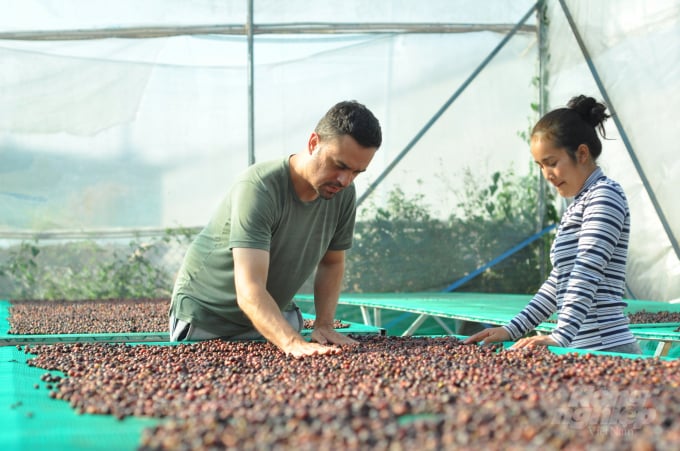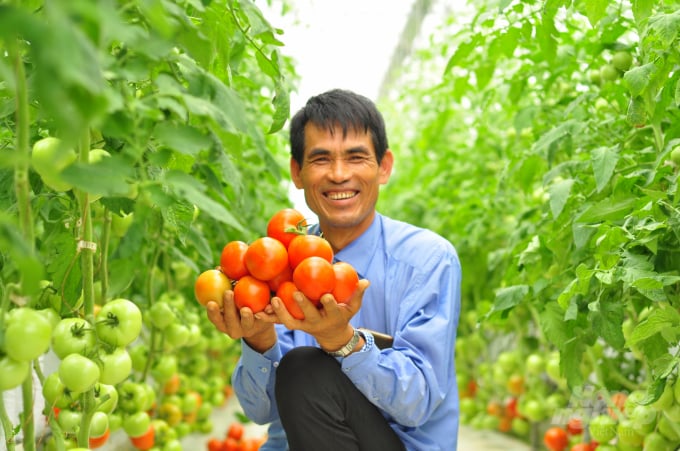November 26, 2025 | 12:07 GMT +7
November 26, 2025 | 12:07 GMT +7
Hotline: 0913.378.918
November 26, 2025 | 12:07 GMT +7
Hotline: 0913.378.918
According to the Lam Dong provincial Sub-department of Plant Protection, the locality has transformed over 10,000 ha of a varied range of plants, assisting the province's agricultural production in achieving rapid growth in productivity, output, production value, and income per unit of cultivation land.
However, the province continues to have 49.4 thousand hectares of unproductive plants that must be converted in order to increase added value and promote sustainable development.

In order to improve coffee productivity, output and value, Lam Dong province has replanted, grafted and improved over 6.3 thousand hectares in districts and cities. Photo: Minh Hau.
In 2022, the Lam Dong agricultural sector will convert 10.4 thousand hectares of inefficient production land and eliminate 4.2 thousand hectares of cultivation land valued at less than VND 50 million per hectare per year. The old one will be replaced by new types of plants that are more economically valuable, produce more, are more qualified, and are more tolerant to climatic change.
Mr. Ha Ngoc Chien, director of Lam Dong's Crops Production and Plant Protection Sub-department, stated that the location is transforming each plant object. Over 6.3 thousand hectares of coffee have been replanted, grafted, and developed in areas such as Di Linh, Bao Lam, Lam Ha, Duc Trong, Dam Rong, Lac Duong, and two cities of Bao Loc and Da Lat. The locality has also converted over 1,000 hectares of land for cashew cultivation and 1.9 thousand hectares of rice fields.
For the effectiveness of the transformation, the province's agriculture sector is reviewing and evaluating areas of ineffective plants with a production value of less than VND 50 million per hectare per year; categorizing the types of plants and production households, as well as cultivation practices, in order to develop a proper transformation plan attached to product consumption through 2025.

Lam Dong's agricultural sector aims to reorganize production in the direction of forming cooperatives, cooperative groups in chains, and focusing on post-harvest handling. Photo: Minh Hau.
Additionally, the province promotes high-quality fruiters by intercropping with industrial orchards such as coffee and cashew, as well as trial planting of certain new fruit varieties in order to enhance the mixed garden and duplicate in the future. Simultaneously, utilizing organic agricultural practices to enhance the quality and worth of products.
Production was oriented toward the formation of cooperatives, chain-linked cooperative groups, and a concentration on post-harvest processing to ensure a consistent supply of high-quality goods while continuing to grant planting area codes to encourage export.
Additionally, Mr. Ha Ngoc Chien, Director of the Lam Dong Crops Production and Plant Protection Sub-Department, stated that the locality practices crop conversion on rice land in conjunction with the establishment of centralized and linked product consumption in order to ensure economic efficiency and sustainability.
Additionally, the agricultural sector develops plans for off-season production of fruiters such as durian, avocado, and macadamia..., diversifies varieties of short-term crops such as vegetables and flowers, and renovates agricultural products' designs, colors, and quality in response to market demand. Additionally, the province successfully adopted a program for importing copyrighted flower varieties to aid in the growth of the flower-producing business between 2021 and 2025.

Lam Dong is a locality with very high agricultural production value, with many areas ranging from hundreds to billions of dong/ha/year. Photo: VAN.
According to the Lam Dong province Crops Production and Plant Protection Sub-Department, plant variety conversion in 2021 contributed to the increase in area and output over 2020. In which total coffee production increased by 2.2 percent to 527 thousand tons; mulberry trees increased by 3.4 percent in area and 29.8 percent in output to 9.5 thousand hectares; fruit trees increased by 20 percent in area and 30.2 percent in output to 235 thousand tons; and macadamia trees increased by nearly 7,000 hectares and nearly 4 thousand tons, an increase of 42 percent in area and 42 percent in output.
In 2021, plant variety transformation resulted in a reduction of 4.3 thousand hectares of land with a production value of less than VND 50 million per hectare, compared to 2020. Increasing the production value per hectare of cultivated land in the whole province to VND 201 million/ha in 2021, a 5% increase over 2020.
Translated by Linh Linh

(VAN) Thanh Hoa province has substantial potential to supply carbon credits, opening opportunities for green economic development, enhancing agriculture and forestry value.
/2025/11/25/1741-0-nongnghiep-221736.jpg)
(VAN) The application of AI helps identify emission sources and assess air pollution developments, thereby supporting management agencies in issuing timely and appropriate control policies.

(VAN) Viet Nam will develop its carbon market not only by prioritizing transaction volumes but also by transitioning to a low-emission economy.
/2025/11/25/3413-1-171953_261.jpg)
(VAN) Experts from the Vietnam Academy of Science and Technology have conducted surveys to identify the causes of landslides in Lam Dong province and propose natural disaster prevention solutions.

(VAN) The HNT reservoir operation support system, developed by WeatherPlus in collaboration with Kyushu Electric Power, enables real-time rainfall forecasting, inflow forecasting, and flood-release simulations.

(VAN) Dr. Cao Duc Phat stated that the localization of early natural disaster warning technologies will help meet practical requirements and create favorable conditions for domestic research institutions and businesses to develop.

(VAN) In addition to improving early-warning technologies, there is a need for software that can guide response actions, track community evacuations, and manage safe zones through digital mapping.